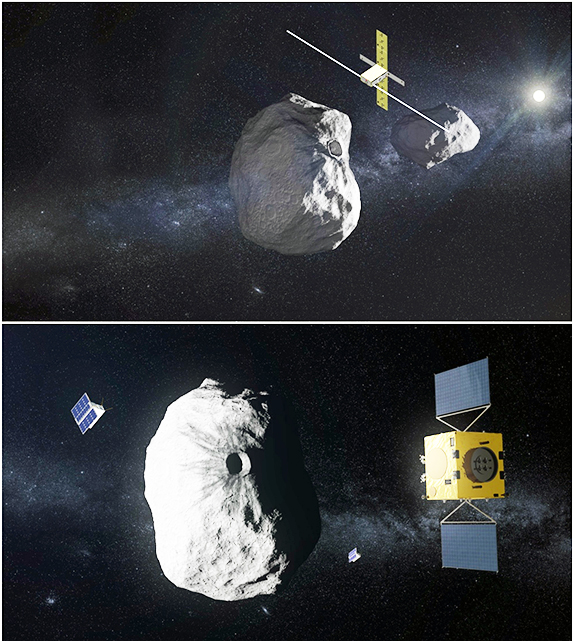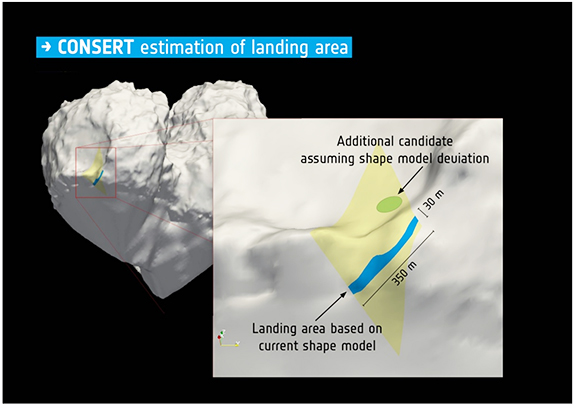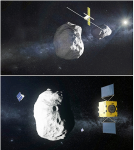

Small enough to be an aircraft carry-on, the ESA’s Juventas spacecraft nevertheless has big mission goals.
Once in orbit around its target body, Juventas will unfurl an antenna larger than itself, to perform the very first subsurface radar survey of an asteroid.
 ESA’s proposed Hera mission for planetary defence will explore the twin Didymos asteroids, but it will not go there alone: it will also serve as mothership for Europe’s first two cubesats to travel into deep space.
ESA’s proposed Hera mission for planetary defence will explore the twin Didymos asteroids, but it will not go there alone: it will also serve as mothership for Europe’s first two cubesats to travel into deep space.

Top: The Juventas CubeSat, to be delivered to the Didymos binary asteroid system by ESA’s proposed Hera mission, will carry a low-frequency radar for subsurface sounding as well as a gravimeter to measure both asteroids’ gravity fields. It will also perform radio science measurements and measure the forces involved in its concluding landing on the smaller of the two asteroids, at the end of its month-long mission. Image is courtesy of ESA/GomSpace.
Bottom: ESA’s Hera mission concept, currently under study, would be humanity’s first mission to a binary asteroid: the 780 m-diameter Didymos is accompanied by a 160 m-diameter secondary body. Hera will study the aftermath of the impact caused by the NASA spacecraft DART on the smaller body. Image is courtesy of ESA–ScienceOffice.org.
Cubesats are smallsat missions based on standardized 10 cm. boxes, making maximum use of commercial off the shelf systems. Juventas will be a ‘6-unit’ cubesat, selected to fly aboard Hera along with the similarly-sized APEX Asteroid Prospection Explorer, built by a Swedish-Finnish-German-Czech consortium.
Juventas — the Roman name for the daughter of Hera — is being developed for ESA by the GomSpace company and GMV in Romania, together with consortia of additional partners developing the spacecraft instruments.
Juventas will deploy a meter and a half long radar antenna, which will unfurl like a tape measure, and was developed by Astronika in Poland. This instrument is based on the heritage of the CONSERT radar that flew on ESA’s Rosetta comet chaser, overseen by Alain Herique of the Institut de Planétologie et d’Astrophysique de Grenoble (IPAG).

Rosetta’s radar used to seek out Philae lander.
Image is courtesy of ESA/Rosetta /Philae.
The radar signals should reach one hundred metres down, giving insight into the asteroid’s internal structure. “Is it a rubble pile, or something more layered, or monolithic?” adds Hannah, who previously worked at asteroid mining company Planetary Resources before moving to GomSpace.
The technology proved itself with the Rosetta, where the CONSERT radar peered deep inside comet 67P/Churyumov–Gerasimenko and helped locate the Philae lander on the comet’s surface. Juventas uses a more compact ‘monostatic’ version of the design.
As Juventas orbits, the CubeSat will also be gathering data on the asteroid’s gravity field using both a dedicated 3-axis ‘gravimeter’ – first developed by the Royal Observatory of Belgium for Japan’s proposed Martian Moons eXploration mission – as well as its radio link back to Hera, measuring any Doppler shifting of communications signals caused by its proximity to the body.
The Hera mission, including its two cubesats, will be presented to ESA’s Space19+ meeting this November, where Europe’s space ministers will take a final decision on flying the mission.
GomSpace systems engineer Hannah Goldberg stated that the company is packing a lot of complexity into the mission. One of the biggest misconceptions about cubesats is that they are simple, but we have all the same systems as a standard-sized spacecraft. Another reputation of cubesats is that they don’t do that much, but there are multiple mission goals over the course of this month-long mission around the smaller Didymos asteroid. One of the company’s cubesat units is devoted to the firm’s low-frequency radar instrument, which will be a first in asteroid science. This is the sort of information that is going to be essential for future mining missions, to estimate where the resources are, how mixed up they are, and how much effort will be required to extract them. The final phase of the mission will come with a precisely-controlled attempt to land on the asteroid. The company will have gyroscopes and accelerometers aboard, so the force of the impact will be captured, as well as any follow-on bouncing, to gain insight into the asteroid’s surface properties — unknown is how well Juventas will continue to operate once it finally touches down. If there is successful operation after the impact, local gravity field measurements from the asteroid surface will continue to be captured.
ESA radar specialist Christopher Buck has worked on the instrument design with IPAG and said the company’s radar instrument’s size and power is much lower than those of previous missions, so what the firm is doing is using a pseudo-random code sequence in the signals — think of it as a poor man’s alternative. Navigation satellites use a comparable technique, allowing receivers to make up for their very low power.

